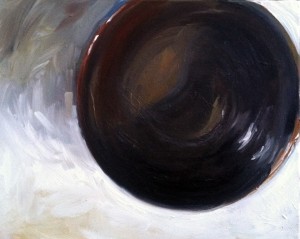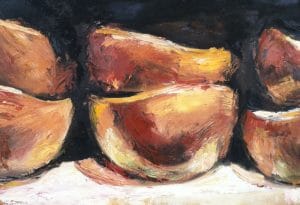“Is it done? Am I finished?”
It’s a tough question sometimes.
Here’s an example of a painting I consider to be “overworked”, and it’s one of MY paintings 🙂

Aaaaargh! When I look at this, the purpose isn’t clear, the relationships between the objects are vague; the shapes are too similar without being rhythmic; there’s a lot of random motion that isn’t really connected to the form; and the color’s just kind of hanging there. Just a pile of mush! Bleh!
Sometimes I have a problem with mush.
Honestly I painted & painted & painted, and could NOT get it to look the way I wanted. I was working from a photograph that I took in a store and I was trying to achieve a certain mood. I wanted tension and balance, like they might fall if someone bumped them. I wanted the bowls to be really different from the plates, in color and form. But my goal wasn’t reachable with the approach I was using – I should have been tight and precise, to create that tension, but with the mood I was in that day, my brush just wanted to fly.
Ironically at one point it was kind of nice, a decent painting, but just not what I had in mind. I should have given up while I was ahead.
Now here’s one of mine that I consider to be successful, because it “works” — the parts (the darks and lights and brushstrokes) add up to a coherent whole. There’s a focal point, a foreground and background. There’s movement around and through the piece. I like the way it’s sort of off-balance, too.

(it’s a bowl, I think it looks like it’s surrounded by feathers – I call it “Bowl’s Eye”)

Here’s another set of bowls that I like – it’s not perfect, but I think the knife strokes (I painted this one with a palette knife) give a bit of motion, but not too much. So there’s a balance between the shape of the bowl and the amount of movement. I wish I’d worked a little more on a couple of spots, but I didn’t know enough about color when I painted this to fix the flaws. So I quit while I was ahead LOLOL! I learned my lesson after the disaster above.
So – what’s the key to avoiding overworking your paintings? Well, I don’t know, but I do have an idea. And it’s an analogy – I like analogies.
I think that making a painting is a lot like rowing a boat.
The boat itself the painter’s skills, like how well they use the paint and understand color, and whether or not they can draw (being able to draw only matters in some paintings). One artist might have put in a lot of time honing their skills, so theirs might be a big, fancy boat capable of doing a lot of things. Another might be a simpler boat. It could be just a raft! But that’s fine, rafts will travel 🙂
The oars are our intention.
And the water is our creative journey or “flow”. It’s the intersection between the things we are seeing on the canvas, what we imagine, what emotional state we’re in, and what we are using as our visual inspiration. Plus a little muse magic 🙂
So here’s the thing.
If we have a LOT of intention and work really hard with those paddles, but our boat isn’t built for speed, then we aren’t going anywhere. If we have the boat we need for the project but we are in still waters (or a storm) we’re not getting anywhere, either.
The trick is proportion – being able to be in the journey, responding to the work that’s developing on the canvas, and having a goal that suits the painter’s skillset.
There’s nothing wrong with changing your journey in the middle of a painting. You might have wanted to paint distant mountains, but you may have instead created a garden, or a lawn with a pond. It’s fine – go for it. Let the paint tell YOU what it wants to say. That’s your inner creativity talking to you, through the paint.
You might be making patterns, shapes that aren’t recognizable as anything. That’s fine, too. Let it happen.
And after you’ve made a few of those pieces and gotten it out of your system, you may be able to go back and paint the distant mountains you intended.
Or – you might stumble on something else that interests you more.






